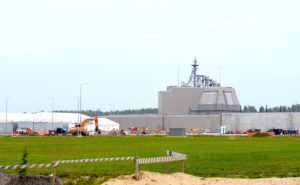The Missile Defense Agency (MDA) said it expects the long-delayed Poland Aegis Ashore site to be ready by 2022, requiring two extra years to fix construction issues.
“To complete the European Phased Adapted Approach (EPAA) phase III, our budget request includes $96 million for the Aegis Ashore site in Poland. Due to construction delays, the site is now planned to be available in 2022,” Michelle Atkinson, MDA director for operations, said during a fiscal year 2021 budget request briefing Monday.

That funding will be on top of original Poland site funding to maintain systems already there to extend the construction timeline.
The EPAA program aims to defend U.S. allies and assets from potential intermediate range ballistic missile from Iran. It uses the Aegis ballistic missile defense system used on cruisers and destroyers. Phase 1 consists of a radar in Turkey, command center in Germany, and ballistic missile defense Aegis destroyers deployed to Europe; Phase 2 consists of the Aegis Ashore site operating in Deveselu, Romania; while Phase 3 consists of the second Aegis Ashore site in Poland.
The Poland site was originally due to be delivered by December 2018, but in early 2018 then-MDA Director Lt. Gen. Samuel Greaves revealed military construction issues caused it to be delayed to 2020 (Defense Daily, March 23, 2018).
Greaves said it was caused, in part, by less than expected performance from the construction contractor and bad seasonal weather (Defense Daily, April 13, 2018)
A June 2019 Government Accountability Office (GAO) report said delays at the site were continuing to accumulate, causing an 18 month delay into May 2020 (Defense Daily, June 7, 2019).
The Army Corps of Engineers manages the contract for the construction site, using a fixed-price contract.
MDA Director Vice Adm. Jon Hill said the main construction contractors have had problems with the “last tactical mile” even though it’s roughly 92 percent completed.
“Well the part that’s not complete is what we really need, which is auxiliary controls, heating, power, cooling, the things that feed a combat system and that’s where that design and engineering that is inside that construction contract has slowed down and where the contractor is having problems,” Hill said.
He said the MDA did an independent assessment of the work in December and consulted with “qualified constructors to assess where we really were” and to see if there is something the department can do to phase the work in earlier.
“Our conclusion is that we need to sit down with the Army Corps and look at contract options and that’s what we’re doing now,” Hill said.
By the end of the month Hill said he will meet with Lt. Gen. Todd Semonite, commanding general of the Army Corps of Engineers, and they will decide on a way forward. He believes it will include contract modifications to the construction side to move faster than the estimated 2022 completion.
Hill underscored the 2022 delivery date is a conservative estimate based on what MDA knows today and how progress has gone over the last few years.
“So it’s a very conservative estimate and that includes Navy acceptance, because you’ve got to do that, that includes European Command acceptance, and there’s always something we talk about, called the technical capability declaration,” he said. “We do that first, we say the system’s up and ready to go and Navy, come accept, EUCOM, come accept.”
Hill acknowledged they may use a new contractor to finish off the work.
“We don’t know yet. There’s a whole stream of options, some of them are straightforward but can we execute them? You know, we’ve got to look at all of the legalities between MILCON and what we can do on the development side.”
Hill said by the end of the month MDA and the department will likely have a ‘go path’ on what it will do to finish the site.